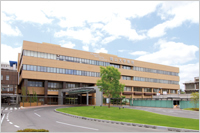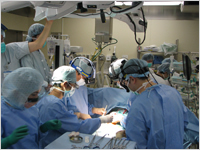Enlarge Image Surgical staff at Okayama University Hospital performing a lung transplant.
Enlarge Image
Okayama University Hospital surgeons perform a record 100 lung transplants exceeding any other hospital in Japan.
Okayama University Hospital is one of the few certified multi-organ transplant centers in Japan, dealing with heart, kidney, lung, liver, small intestine, and the transplant of other organs. The Okayama University Hospital Organ Transplant Center was opened in January 2011 as the first facility of its kind in Japan to specifically handle all aspects of transplantation surgery.
Doctors at Okayama University Hospital have performed a large number of organ transplants, including kidneys, livers, and lungs. The hospital succeeded in performing the first living-donor lung transplant in Japan in 1998, as well as a successful lung transplant from a brain-dead donor in 2002. In November 2012 the hospital was the first in Japan to reach a total of 100 lung transplants, including 39 from brain-dead donors, giving it the highest number of such operations in Japan.
According to data published by the International Society for Heart & Lung Transplantation, the global average success rate for lung transplantation is 90% with a survival rate after one year of 70% and after five years of 50%. Okayama University Hospital's lung transplant survival rate after five years stands at 82% (87% for transplants from living donors). This is an extremely good performance in comparison to the global average, garnering attention worldwide for the hospital as a top level lung transplant facility.
The hospital also performed the first successful simultaneous kidney and liver transplant from a brain-dead donor in Japan in September 2012.


